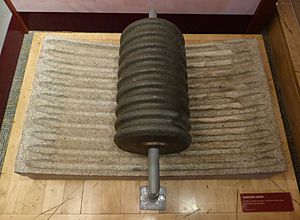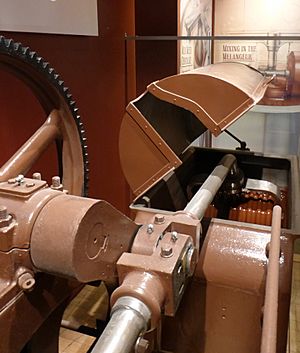Conching facts for kids
Conching is a special step in making chocolate. It uses a machine called a conche to mix and stir chocolate ingredients for a long time. This process helps spread the cocoa butter evenly throughout the chocolate. It also makes the chocolate particles very smooth.
Conching also helps the chocolate taste better. The mixing creates heat, which releases flavors and removes unwanted acids. The name "conche" comes from the early machines, which looked like conch shells.
Chocolate can be conched for many hours, sometimes up to 78 hours, to get a rich, mild taste. Cheaper chocolate might only be conched for about 6 hours. Because conching is so important for how chocolate tastes and feels, companies often keep their exact methods a secret!
Contents
How Conching Was Invented
Rodolphe Lindt invented the first conche machine in Berne, Switzerland, in 1879. His invention made chocolate taste and melt much better than before.
The story goes that Lindt accidentally left his chocolate mixer running over a weekend. When he came back, he found the chocolate was different. It was much smoother and shinier than the "gritty" chocolate people usually made back then.
Lindt's invention was a big deal! It made it possible to mass-produce chocolate bars. Before this, most chocolate was consumed as a drink.
Lindt's first conche used a heavy granite roller and a granite trough. This type is now called a "long conche." It could take more than a day to process a large batch of chocolate. Modern conches are much faster. They can process huge amounts of chocolate in less than 12 hours. These new machines have special cooled containers and powerful mixers.
What Happens During Conching
During conching, the dry parts of the cocoa mix well with the fat (cocoa butter). Air flows through the conche, which helps remove unwanted acids. These acids can make chocolate taste a bit sour. Conching also reduces moisture in the chocolate. Too much moisture can make the chocolate very thick. That's why machines are cleaned with cocoa butter, not water!
The heat in the conche also changes the chocolate's flavor. Some substances from the roasted cocoa beans get oxidized, which makes the flavor smoother.
The temperature inside the conche is carefully controlled. It changes depending on the type of chocolate. For example, milk chocolate might be conched around 49 degrees Celsius (120 degrees Fahrenheit). Dark chocolate can go up to 82 degrees Celsius (180 degrees Fahrenheit). Higher temperatures usually mean the chocolate needs less time to conche.
The Three Phases of Conching
Chocolate goes through three main stages during conching:
Dry Phase
At first, the chocolate mixture is like a powder. The mixing coats these tiny particles with fat. Air moving through the conche helps remove moisture and other things that can make the chocolate taste acidic.
Pasty Phase
In this stage, more of the chocolate particles get covered in fat. The mixture starts to become thicker, like a paste. The machine needs more power to keep mixing at this point.
Liquid Phase
Finally, the chocolate becomes a smooth liquid. At this stage, manufacturers can add a little more fat or special ingredients called emulsifiers. This helps adjust how thick or thin the chocolate is, depending on what it will be used for.
Most conches process chocolate in batches. But some modern conches work continuously. This means the chocolate moves through different sections of the machine, making the process even faster. For example, milk chocolate can be conched in as little as four hours with a continuous conche.
Images for kids
See also
 In Spanish: Conche para niños
In Spanish: Conche para niños





